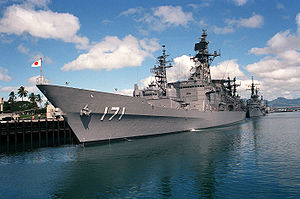Hatakaze-class destroyer
 Hatakaze (DDG-171) docked in Pearl Harbor, 1988 | |
| Class overview | |
|---|---|
| Name | Hatakaze class |
| Builders | Mitsubishi Heavy Industries |
| Operators |  Japan Maritime Self-Defense Force Japan Maritime Self-Defense Force |
| Preceded by | Tachikaze class |
| Succeeded by | Kongō class |
| Cost |
|
| Built | 1983–1988 |
| In commission | 1986–present |
| Completed | 2 |
| Active | 2 |
| General characteristics | |
| Type | Guided-missile destroyer |
| Displacement |
|
| Length | 150 m (492 ft 2 in) |
| Beam | 16.4 m (53 ft 10 in) |
| Draft | 4.8 m (15 ft 9 in) |
| Propulsion |
|
| Speed | 30 knots (56 km/h; 35 mph) |
| Complement | 260 |
| Armament |
|
The Hatakaze class of guided-missile destroyers is a third generation class of vessels in service with the Japan Maritime Self-Defense Force (JMSDF). They were the first of the JMSDF's ships to have gas-turbine propulsion.
The core weapon suite is similar to that of the preceding Tachikaze class, but various improvements were made in many areas. Most notable are those that allow the Hatakaze class to function as a group flagship. Normally this duty resides with a larger type of ship, but in case of their absence due to repairs, accident, or battle damage, the Hatakaze design allows for it to function as a command ship.
Hatakaze destroyers operate the OYQ-4-1 type tactical control system. Its weapon systems include the Standard missile surface-to-air missile, anti-submarine rockets, the RGM-84 Harpoon anti-ship missile, two Mark 15 20 mm CIWS gun mounts, two torpedo mounts in a triple tube configuration and two 5 inch/54 caliber Mark 42 rapid-fire guns.
Ships in the class
| Building no. | Pennant no. | Name | Laid down | Launched | Commissioned | Home port | Note |
|---|---|---|---|---|---|---|---|
| 2311 | DDG-171 TV-3520 | Hatakaze | 20 May 1983 | 9 November 1984 | 27 March 1986 | Yokosuka | Converted to training vessel (TV-3520) on 19 March 2020[1] |
| 2312 | DDG-172 TV-3521 | Shimakaze | 13 January 1985 | 30 January 1987 | 23 March 1988 | Sasebo | Converted to training vessel (TV-3521) on 19 March 2021[1] |
See also
References
- ^ a b 海人社, ed. (May 2021). "「あまつかぜ」から「しまかぜ」まで 海自在来型DDGを振り返る" [From "Amatsukaze" to "Shimakaze": Looking back on the DDG]. 世界の艦船 (in Japanese) (947). 海人社: 43–51.NAID 40022529062
External links

- GlobalSecurity.org; JMSDF DDG Hatakaze Class
- v
- t
- e
- Hatakaze
- Shimakaze
- Preceded by: Tachikaze class
- Followed by: Kongō class
- List of destroyers of the Japan Maritime Self-Defense Force












